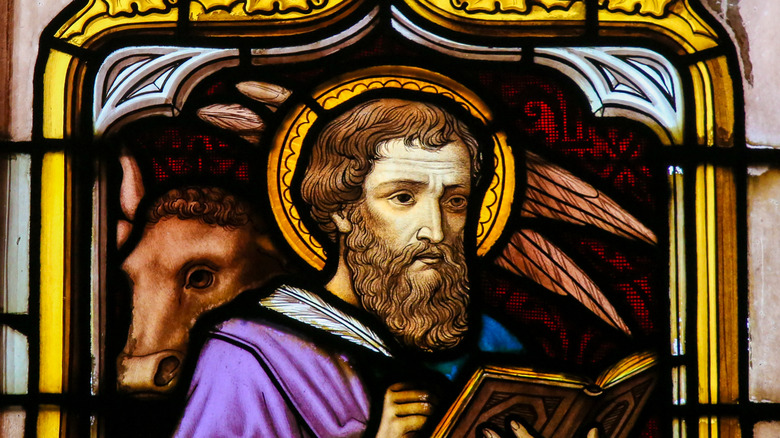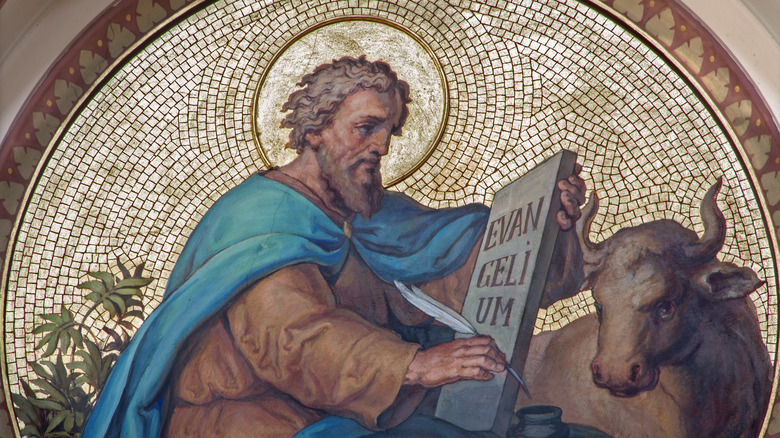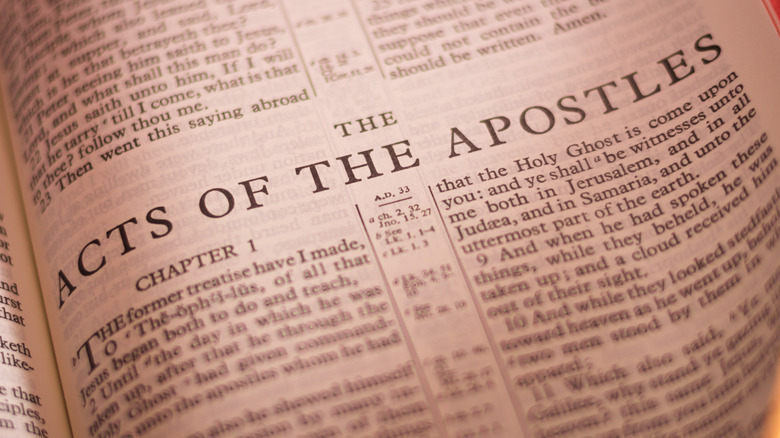The Untold Truth Of The Gospel Of Luke
The Gospel of Luke, or the Gospel According to Luke, is a famous teaching that originates from the New Testament in the Bible. It is one of the four gospels written about Jesus Christ, and together they detail the life of the young Messiah from the time he was born until his death (via Britannica). The four authors of the gospels are four Saints named Matthew, Mark, Luke, and John, per Bible History. The first three gospels are often referred to as the Synoptic Gospels, says Christianity. In order of the years that they were written, the third gospel's author was Saint Luke — hence the name of the eponymous gospel. All of them also follow a sequential timeline.
Luke was a Greek evangelist and physician, and his gospel is unique because it is the only one that presents certain information that isn't found anywhere else in the Bible. As a result, the Gospel of Luke is a biblical account of great importance to scholars and the faithful.
How Luke's gospel differs
The Gospel of Luke comes third in the order of the gospels, and although his name is not mentioned (Biblica), historians believe that it was written by Luke sometime in the first or second century (via Britannica). The date of its writing is somewhat debated, however, but many accounts pin the date of authorship from 80 to 90 A.D., says this Catholic Bishops website. Some research, however, contends that it may have been written a bit earlier — in 60 to 65 A.D. (via Christianity).
Whenever it was written, it came after Christ died and was resurrected. In the gospel, Luke explores lessons on compassion, and Jesus' determination and commitment to wanting to save humanity from the tribulations of life. He also recalls several accounts from Jesus that only Luke mentions in his gospel. According to the National Catholic Register, there are more than two dozen sections of the gospel that can only be found in Luke.
The story of Jesus coming to life
One of the most recognized of these stories is only found in the Gospel of Luke — chapter 1, verses 28-38 (via Bible Gateway). It tells the story of the angel Gabriel who was sent by God to deliver a message to a virgin woman expecting to be married. That unmarried woman was Mary, and her future husband was Joseph. God sent Gabriel to inform Mary that despite being a virgin, she would become pregnant and have a son she was asked to name Jesus. It is the sole reference that explains the forthcoming miraculous birth of Jesus, says Why Christmas. The verses also discuss another miracle — that of Mary's cousin, Elizabeth. Throughout Luke, Elizabeth is referenced as an older female relative of Mary's who took her in, per Women in the Bible. Although Elizabeth was described as being older than childbearing age and was thought to be unable to have children, Elizabeth eventually gave birth to a boy, who came to be known as John the Baptist.
These particular areas of the gospel help give understanding to Jesus' family and what happened before he was born on Christmas day.
Who is Luke?
Of the four gospel authors of the New Testament, Luke is the only one who was not Jewish, per Britannica. This is noted, because he speaks of non-Jews, commonly referred to as gentiles, in the gospel and talks about their faith. He writes that Jesus in particular displayed support for gentiles and their beliefs, and how he loved everyone regardless of their faith (via Catholic Online).
What is known about Luke is that he was Greek, an evangelist, and was born in the ancient city of Antioch (now part of Turkey) in Greek-ruled Syria. He was also possibly was born into enslavement. Luke was not just the author of the famous third Gospel, but he is also highly believed to be the author of Acts, or Acts of the Apostles (via Britannica), another book in the New Testament. Many historians class Acts as a second part to Luke's Gospel (via PBS).
The relationship between the Gospel of Luke and Acts
Aside from having the same author, the content of Luke's Gospel and Acts are so connected that the latter has been referred to as a second part of the former, says Drive Thru History. In both of them, a man named Theophilus is being addressed. He is the subject to whom Luke is speaking when he is recalling Jesus' life story. This is how historians have placed Luke as the sole writer of the texts.
The introduction of Acts also resumes where Luke's Gospel concludes. This is noted by Luke's immediate mention of Theophilus in the first three verses of Acts (per Bible Gateway). Despite the two writings being related, most religious historians do not order Acts as coming after Luke's gospel. Instead, it comes after John. The explanation is based on the order of their translation in ancient times as well, as the recollection of the time that they were written, says this Catholic church website. So even though Acts came right after the Gospel of Luke, John's gospel still precedes it. As a result, it was completely separated from what is now recognized as the four gospels of the New Testament.
Length of the gospel
One would think that because Luke has authored two writings that are connected, he's written a major portion of texts in the Bible — and that assumption would be accurate.
Although most references class Luke's Gospel and Acts separately, they have the same author — so we know that he contributed a lot to the New Testament. But just by how much? The Gospel of Matthew is shown to beat out Luke with the numbers of chapters of each of the four books, with 28. But Luke's (which is 24 chapters) has it beat by the number of words. Per Catholic Resources, Luke wrote 19,482 words in his Gospel alone, whereas Matthews wrote 18,345 words. However if one were to include Acts, which is even more than Matthew's gospel at 18,451 words — that brings the total number of words that Luke has written to 37,933. In addition to that, both Acts and Matthew have an equal number of chapters. This fact means that Luke is the person who has written the most words and chapters in the Bible.





